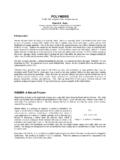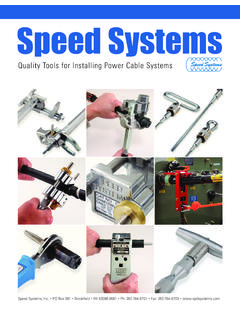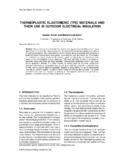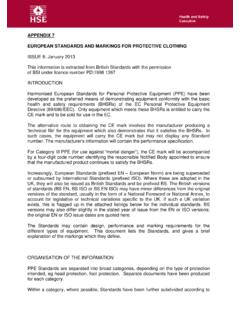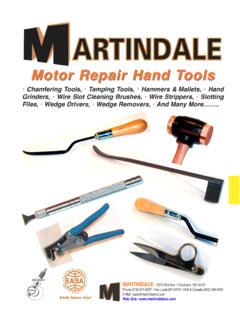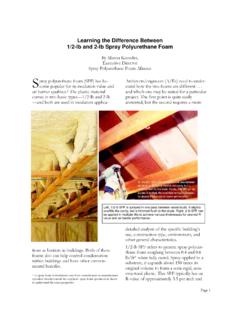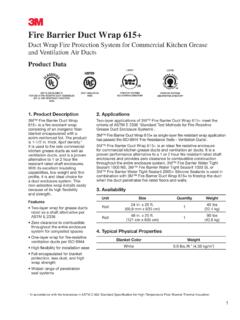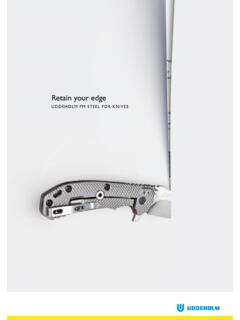Transcription of Plastic identification codes - CANSA
1 plastics |SA Plastic identification CODESThe SPI resin identification coding system is a set of symbols placed on plastics to identify the polymer type. It was developed by the Society of the Plasticsis used internationally, voluntarilyPlastics|SA is encouraging the South African plastics industry to use the symbol on all Plastic products. The primary purpose of the codifferent polymer types for recycling. The universal recycling symbolsymbol for recyclable materials. It consists of three chasing arrM bius strip. Because the material identification codessimilar to the recycling symbol, they are often regarded as recycling signs. The following table explains the material identification codes and list some examples of where they cansurrounding the specific material Material Material identification code PET Poly(ethylene terephthalate) PET bottles can be re-used. They do not contain phthalates . Beverage PET bottles are widely recycled in South Africa and the recyclatebedding and industrial uses.
2 A small percentage is also recycled back into food contact applications, thermoformed trays and punnets and bottles for mineral water and raw material is manufacture PE-HD High density polyethylene PE-HD is suitable for industrial chemical packaging as it is an inert material and does not react easily with the contents. tensile strength, even in relatively low micron applications. South Africa by Safripol. Information provided in good faith Plastic identification CODESThe SPI resin identification coding system is a set of symbols placed on plastics to identify the polymer type. It was developed by the Society of the plastics Industry (SPI) in 1988 and , voluntarily. Omission of the symbol is often due to ignorance and plastics |SA is encouraging the South African plastics industry to use the symbol on all The primary purpose of the codes is to allow efficient separation of different polymer types for recycling. recycling symbol is an internationally recognised symbol for recyclable materials.
3 It consists of three chasing arrows, or material identification codes look very similar to the recycling symbol, they are often regarded as recycling The following table explains the material identification codes and list some examples of where they can be found. Some of the myths surrounding the specific material are also briefly discussed. Packaging Non-packagingMaterial identification Product examples Material identification code Carbonated drink bottles, mineral water bottles, clear bottles used for dishwashing liquids, edible oils; etc. Jars, Salad domes, Biscuit trays, Punnets. >PET< used. They do not contain phthalates . Beverage PET bottles are widely recycled in South Africa and the recyclate is used in fibre applications for apparel, bedding and industrial uses. A small percentage is also recycled back into food contact applications, thermoformed trays and punnets and bottles for mineral water and raw material is manufactured in South Africa by Hosaf (Pty) Ltd.
4 Milk bottles, fruit juice bottles, drums, packaging films, carrier type shopping bags, tubs, closures, cosmetic bottles, crates, pallets, bins >PE-HD< HD is suitable for industrial chemical packaging as it is an inert material and does not react easily with the contents. Vest-type carrier bags are made from PE-HD for its high tensile strength, even in relatively low micron applications. The material is manufactured in Page 1 of 5 Plastic identification codes The SPI resin identification coding system is a set of symbols placed on plastics to identify Industry (SPI) in 1988 and Omission of the symbol is often due to ignorance and plastics |SA is encouraging the South African plastics industry to use the symbol on all des is to allow efficient separation of packaging Product examples Carpeting, fibres for apparel and industrial applications. Engineering components, sewing machine parts. used. They do not contain phthalates . Beverage PET bottles are is used in fibre applications for apparel, bedding and industrial uses.
5 A small percentage is also recycled back into food contact applications, thermoformed trays and punnets and bottles for mineral water and juices. Irrigation pipes, water reticulation, shade-cloth, netting, shopping trolleys, refuse bins, toys, medical implants, hip replacement components HD is suitable for industrial chemical packaging as it is an inert material and does not HD for its high The material is manufactured in Figure 1: Universal Recycling Symbol plastics |SA Information provided in good faith Page 2 of 5 PVC-P Flexible Poly(vinyl chloride) Industrial cling film, pouches >PVC-P< Cable insulation, gum boots, shoe soles, flooring, matting, medical cloth and tubing, tarpaulins, hoses, safety gloves, soft toys, rain wear, erasers, see-through vinyl curtains, banners, supported cloth used for rubber ducks, jumping castles, tents and upholstery, unsupported cloth used for shower curtains and water proofing applications, etc. Automotive, soft interior leather finish applications.
6 PVC is never used on its own. The material consists of a combination of additives. The flexibility in PVC-P is obtained from plasticisers. There are more than twenty potential plasticisers that can be used to soften PVC and the selection is based on the cost of the final product, the application and the presence of other ingredients in the compound. Some of the plasticisers are called phthalates, which again is a generic term for a range of chemicals. There is international pressure to phase out some of the phthalates as there are indications that they are some that may be carcinogenic. This is not applicable to all plasticisers. In South Africa, there are commitments to phase out DEHP plasticisers. For years already, it has not been locally used for food contact applications or toys. Not all phthalates are used as plasticisers for PVC. Different phthalates keep nail polish from chipping, make perfume linger longer, or make tool handles strong and more resistant to breaking.
7 Others help adhesives, sealants, paint pigments and many other materials perform their jobs better. Flexible PVC is very popular for recycling and find applications in shoe soles and industrial hoses. PVC raw material is manufactured from 50% salt and is locally made by Sasol Polymers. PVC-U Rigid Poly(vinyl chloride) Limited use in clear bottles and jars. Blister packaging, food packaging, inserts, chocolate trays. >PVC-U< Pipes for water reticulation and sewage, conduit, profiles, cladding, stationery foils, plumbing, skirting, cornices, trunking, cooling tower packing, building panels, etc PVC is never used on its own. The material consists of a combination of additives. Rigid PVC does not contain plasticisers and therefore the un-plasticised part in the name, PVC-U. Rigid PVC can successfully be stabilised for UV resistance for outdoor applications and is the plastics |SA Information provided in good faith Page 3 of 5 only material that will maintain its strength for more than 20 years in the sun.
8 It is therefore widely used in the construction and building industry. Rigid PVC is hardly used in packaging. The bulk of solid domestic waste is incinerated in Europe and the chlorine in PVC packaging needs to be specially dealt with in incineration systems which are expensive. Pressure from the European governments resulted in very little PVC used for packaging. Uncontaminated rigid PVC is recycled in South Africa and the recyclate is used for conduit and sewage pipes. The PVC raw material is manufactured in South Africa by Sasol Polymers. A number of compounding companies manufacture PVC compounds, either rigid or flexible. Some manufacturers compound their own raw materials prior to the manufacturing of products. PE-LD and PE-LLD Low and Linear low density polyethylene Packaging films, domestic cling film, stretch wrap, shrink wrap, bags, shrouds, dust covers, peel-able lids, cosmetic tubes, boutique shopping bags >PE-LD< Irrigation pipes, cable insulation, agricultural films, rotational moulded products, tanks and corner protectors.
9 Bubble wrap, airothene foam sheeting, etc. PE-LD is a very good material for flexible packaging as it is the Plastic material with the highest impact strength. It is an inert material and will not react with the contents. It is used for food application films as well as for flexible industrial packaging. PE-LD is the most popular material for recycling and over 100 000 tons are recycled per annum. Recycled PE-LD is used for film again in packaging and industrial applications. It is also used in irrigation piping. PE-LD is locally made by Sasol Polymers. PP Polypropylene Yoghurt tubs, margarine tubs, ice cream containers, wrappers, packaging films, bottles, caps and closures, canisters, strapping tape, woven bags, crates >PP< Coat hangers, battery cases, reels, automotive components incl. bumpers, furniture, bowls, buckets, carpeting, non-wovens, bristles, hair extensions, appliances, toasters and kettles. Toilet seats, ropes, fishing nets PP is one of the plastics that have the highest variety of applications.
10 The material is slightly more heat resistant than PE-HD and is used in hot filling and microwavable applications. PP is an inert material and will not chemically interact with the contents. PP is not resistant to acids and therefore not used in acidic industrial applications. PP maintains its stiffness even at very low thicknesses and is therefore a very cost effective packaging material in thin-wall applications like drinking straws and take-away food tubs. It is very popular for recycling and the demand for recycled PP is far greater than the plastics |SA Information provided in good faith Page 4 of 5 available supply. High levels of soiling in the domestic solid waste stream limit the recycling from this source. PP is used as a homopolymer and a copolymer and is locally manufactured by Safripol and Sasol Polymers. South Africa exports high volumes of PP raw material to the rest of the world. PS and PS-HI Polystyrene (general purpose and high impact) Yoghurt and other diary product tubs, display boxes, cake domes, punnets >PS< Coat hangers, take-away cutlery, take-away crockery, toys, cups, plates, audio and video cassette housings, CD and DVD covers, housings, cell phone covers, stationery items, pens and rulers, toys, watch glasses, shower doors, office drawers, stationery trays, etc Polystyrene comes in many different formats.









